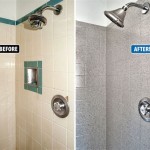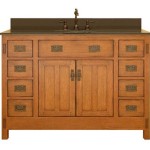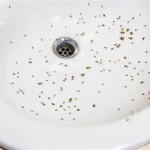How To Fit New Bathroom Sink Tap Washers
Leaky taps are a common household problem. Often, these leaks are attributable to worn or damaged washers within the tap mechanism. Replacing these washers is a relatively straightforward plumbing task that can save water and prevent further damage to your sink area. This article provides a comprehensive guide on how to fit new bathroom sink tap washers, covering the necessary tools, preparation steps, and a detailed procedure.
Before embarking on this repair, it is crucial to identify the type of tap you have. Common types include compression taps, ceramic disc taps, and ball taps. The procedures for replacing washers may vary slightly depending on the tap type, though the general principles remain the same. This guide primarily focuses on compression taps, as they are the most common type featuring accessible washers.
Safety is paramount when dealing with plumbing. Always turn off the water supply to the tap before starting any work. This usually involves locating the isolation valves beneath the sink or, if these are absent, turning off the main water supply to the property. Failure to isolate the water supply will result in water damage and require significantly more extensive repairs.
Preparation and Necessary Tools
Proper preparation is essential for a smooth and efficient repair. Gathering the necessary tools and materials before starting the project will minimize disruptions and ensure you have everything you need on hand.
First, you will need a set of screwdrivers, including both flathead and Phillips head types. The specific sizes required will depend on the tap design. A small adjustable spanner or a set of open-end wrenches is also necessary for loosening and tightening nuts and bolts within the tap assembly. A pair of pliers can be useful for gripping small parts and removing stubborn washers.
A basin wrench, also known as a faucet wrench, can be beneficial for accessing tight spaces under the sink. These wrenches are designed to reach up behind the sink and turn the nuts that secure the tap to the basin. While not always necessary, they can greatly simplify the process, particularly for taps with complex mounting arrangements.
New tap washers are, of course, essential. Before purchasing these, it is advisable to disassemble the tap and inspect the existing washers to determine the correct size and type. Washers are typically made of rubber or neoprene and come in various diameters and thicknesses. Ensure the new washers are compatible with your tap and are of a good quality to ensure a long-lasting repair.
In addition to tools and washers, a few other materials will be helpful. A small container or tray is useful for storing disassembled parts and preventing them from being lost. A cloth or towel should be used to protect the sink surface from scratches and to absorb any water spills. Some plumbers' grease can also be applied to the tap threads during reassembly to facilitate smooth operation and prevent future corrosion.
Finally, a descaling solution may be beneficial if the tap components are heavily scaled or corroded. This can help to remove deposits and ensure a proper seal with the new washers.
Step-by-Step Guide to Washer Replacement
With the tools and materials gathered and the water supply isolated, the next step is to disassemble the tap and replace the worn washers. This process involves several stages, each requiring careful attention to detail.
The first step is to remove the decorative cap or cover on the tap handle. This cap typically conceals a screw that secures the handle to the valve stem. Gently pry off the cap using a small flathead screwdriver. Be careful not to scratch or damage the tap finish.
Once the cap is removed, unscrew the screw securing the handle. The handle should then lift off the valve stem. If the handle is stuck, you may need to gently wiggle it or use a lubricant to loosen it. Avoid applying excessive force, as this could damage the handle or the valve stem.
With the handle removed, the valve stem will be exposed. Use an adjustable spanner or open-end wrench to loosen the nut that secures the valve stem to the tap body. Turn the nut counterclockwise to loosen it. Be prepared for a small amount of residual water to escape as the nut is loosened.
Once the nut is loosened, carefully pull the valve stem out of the tap body. The valve stem is the component that controls the flow of water through the tap. At the bottom of the valve stem, you will find the old washer. This washer will likely be worn, cracked, or flattened.
Remove the old washer from the valve stem. In some cases, the washer may be held in place by a small screw or a retaining clip. Use a screwdriver or pliers to remove the screw or clip and extract the old washer. If the washer is stuck, you may need to use a small pick or knife to carefully pry it loose.
Clean the valve stem thoroughly to remove any debris or corrosion. Ensure the surface where the new washer will sit is clean and smooth. Apply a small amount of plumbers' grease to the threads of the valve stem to lubricate it and prevent future corrosion.
Install the new washer onto the valve stem. Ensure the washer is correctly seated and secured in place with the screw or retaining clip. The washer should fit snugly and be properly aligned with the valve stem.
Carefully reinsert the valve stem into the tap body. Align the valve stem with the tap body and gently push it into place. Ensure the valve stem is fully seated and that the nut can be easily tightened.
Tighten the nut securing the valve stem to the tap body. Turn the nut clockwise to tighten it. Do not overtighten the nut, as this could damage the tap body or the valve stem. Tighten the nut until it is snug and secure.
Reattach the tap handle to the valve stem. Align the handle with the valve stem and push it into place. Secure the handle with the screw and replace the decorative cap or cover.
Repeat the process for the other tap, if necessary. If you have a pair of taps, repeat the above steps for the other tap to ensure both taps are functioning correctly. This is important, even if only one tap was leaking, as the other tap may have a similarly worn washer.
Testing and Post-Repair Checks
After replacing the washers and reassembling the tap, it is essential to test the repair and check for any leaks or other issues. This will ensure the repair has been successful and prevent any further problems.
Slowly turn on the water supply to the tap. Start by opening the isolation valves or the main water supply valve gradually. This will allow the water pressure to build up slowly and prevent any sudden bursts or leaks.
Check for leaks around the tap body, the valve stem, and the handle. Look for any signs of water dripping or seeping from these areas. If you find any leaks, immediately turn off the water supply and re-examine the tap assembly. You may need to tighten the nuts or screws further, or you may need to replace the washers again.
Operate the tap handle to test the water flow. Turn the tap on and off several times to ensure the water flows smoothly and stops completely when the tap is turned off. Listen for any unusual noises or vibrations. If the water flow is restricted or if you hear any noises, there may be a blockage in the tap body or the valve stem.
Inspect the sink drain for any leaks. While you have the water running, check the sink drain for any leaks around the drain flange or the drainpipe connections. This is a good opportunity to identify any other potential plumbing issues.
Clean up the work area. Once you are satisfied that the repair has been successful, clean up the work area and dispose of any old washers or materials. Ensure the sink is clean and dry.
If the tap continues to leak after replacing the washers, there may be other issues with the tap, such as a damaged valve seat or a cracked tap body. In these cases, it may be necessary to replace the entire tap. Consulting a qualified plumber is advisable if you are unsure or uncomfortable with proceeding further.
Regular maintenance of your taps can help to prevent leaks and prolong their lifespan. This includes periodically cleaning the tap spouts and handles, checking for leaks, and replacing worn washers as needed. By following these simple steps, you can keep your bathroom sink taps in good working order and avoid costly repairs.

How To Replace A Tap Washer

How To Change A Washer On Mixer Tap Homeserve

How To Change A Tap Washer

How To Replace A Tap Washer In 10 Easy Steps Hpg Solutions

How To Change A Washer On Mixer Tap Bathroom Ideas

Dripping Tap How To Change A Faucet Washer Installation Of New Leaking Bath Sink Basin

How To Change A Tap Washer

Your Guide To Replacing Tap Washers Qs Supplies

How To Change A Washer On Mixer Tap Ps Plumber Singapore

How To Change A Tap Washer
Related Posts







